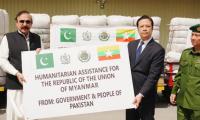According to scientists working on global weather patterns, rising global temperatures are causing the glaciers in the Himalayas as well as in Europe and other parts of the world to melt. This will cause major portions of Asia, Africa, the US and South America to turn into uninhabitable deserts.
As a result of these climate changes, extreme flooding will occur in some areas and severe droughts in others – resulting in a large number of deaths. It has been predicted that many animal and plant species will vanish and the population on the planet will rise to 9 billion by the year 2050. However, it may diminish rapidly thereafter due to mass famines and wars. This is a terrifying scenario if the average temperature on the planet increases by only four degrees Celsius.
The last time that global temperature increases of this magnitude occurred was 55 million years ago when large amounts of frozen methane were released from deep oceans causing the temperature to rise by five to six degrees Celsius. This resulted in the emergence of tropical forests in polar regions, desertification of vast areas of southern Africa and Europe and extermination of sea life due to acidity caused by the presence of dissolved carbon dioxide in oceans.
According to the intergovernmental panel on climate change (IPCC), doubling of world carbon dioxide levels are likely to increase the average global temperatures by three degrees Celsius. With increasing humidity levels, many parts of our planet will become uninhabitable within the next 10 decades unless we take drastic action to control the burning of fossil fuels which is causing higher levels of carbon dioxide, leading to global warming.
According to some US and Australian scientists, many parts of our planet will become uninhabitable within a century due to the increased heat and humidity. Pakistan is one of the regions that is predicted to be most seriously affected. A large number of people are dying in Europe each year due to the increasingly hot temperatures. In France alone, about 13,800 people died of heat stroke in 2003. The annual death numbers due to hot weather around the world are estimated to be in tens of thousands. Children and the elderly are most vulnerable. With President-designate Trump of the US threatening to withdraw from the Paris climate accord and calling the global rise in temperatures a hoax created by China, the threat has become even more serious.
It is often not realised that it is atmospheric humidity that is the real threat of rising temperatures. As world temperatures rise, there is greater evaporation of water from oceans leading to rising humidity. Our body can function within certain temperature limits. The normal body temperature is about 37 degrees Celsius but if it rises above 42 degrees Celsius, we die. The pores present in our body allow sweating to occur that leads to a cooling effect through evaporation and compensates for the heat. However if humidity rises, the evaporation (and the corresponding cooling effect) is reduced, resulting in serious stress on our bodies.
In dry-hot weather, we can tolerate atmospheric temperatures for up to 50 degrees Celsius or even higher – for short periods of time – because of the cooling effect from evaporation of sweat from our skin. However when it is humid, our skin temperature should not increase above 35 degrees Celsius for more than a few hours. For this reason the ‘wet-bulb’ temperature (temperature recorded by a mercury thermometer wrapped in a wet cloth) is considered more relevant when considering stress on human bodies.
Even healthy people don’t survive sustained wet-bulb temperatures of above 35 degrees Celsius for more than a few hours. The maximum wet bulb temperatures do not normally exceed 31 degrees Celsius. However as global temperatures rise, the accompanying increases in the levels of humidity is causing wet bulb temperatures to rise, posing a serious risk to life on earth.
The unsustainable use of water and land due to intensive production of crops is creating another major problem which could send the world spinning into a crisis of unprecedented magnitude. According to the World Bank, about 175 million people in India are able to be fed because crops receive water due to over-pumping. However, water being pumped from underground aquifers faster than it can be replenished is resulting in the water table receding at an alarming rate.
Wheat production in Saudi Arabia is dependent on water from an aquifer which is running dry which means wheat production could stop in a couple of years. There are about 1.5 million new mouths to feed every week as the global population grows, which further aggravates the situation.
The unpredictability of weather patterns is another serious factor which could lead to a global disaster. The heatwave in Moscow in 2010 resulted in a loss of 40 percent of the hundred million tonne grain crop. If this had occurred in India, China or the US, it could have had a devastating impact on world grain production. Food prices have been rising at an alarming rate in most countries, making life miserable for the vast majority of people. The highly controversial building of dams in India which would divert water from Pakistan, could eventually lead to a nuclear conflagration between these two states.
Access to safe drinking water is another major challenge in Pakistan and other developing countries. According to WHO, around four billion people are diagnosed with diarrhoea and around two million die each year due to the scarcity of clean water. These figures mainly include children under the age of five. The problem is particularly grave after the occurrence of floods where the breakout of diarrhoea is often reported from several regions.
However, a cheap and effective technology is now available for purifying water which most people are not aware of. Known as SODIS (solar water disinfection), the technology requires only one litre transparent plastic (PET) bottles and sun light! These commonly found plastic bottles allow the UV light to pass through, killing germs and making water drinkable. If the water is muddy, it should first be filtered through a piece of cloth in order to remove dirt particles. One-litre bottles work best, but two-litre bottles may also be used. The bottle is placed for a minimum of six hours in sunlight and the water can then be drunk directly from it.
The bottles must not be old or heavily scratched and any labels should be removed in order to allow light to pass through unobstructed. This easy way of purifying water has been implemented in 33 countries on recommendation of WHO. The government of Pakistan agencies and NGOs should make information about this technology available across the country as it can save thousands of lives.
The writer is chairman of UN ESCAP
Committee on Science Technology &
Innovation and former chairman of the HEC. Email: ibne_sina@hotmail.com
This demand has fueled rapid growth deposit base of Islamic Banks and Islamic Windows operated by conventional banks
But Punjab Agriculture Food and Drug Authority building near Thokar Niazbeg on Multan Road stands out
Macron has been particularly vocal in their criticism, asserting that withholding arms from Kyiv plays directly into...
As PPP governs province, Bilawal Bhutto Zardari holds strategic position to address both violence and its underlying...
Critics argue that strategy is vague, but closer look indicates strategic alignment with global trends and national...
To defeat it, we must distrust bot-driven narratives, to defeat it, we must verify sources before believing or sharing







